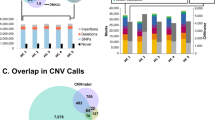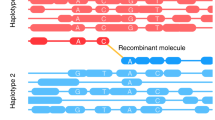Abstract
Recent large-scale mutagenesis screens have made the zebrafish the first vertebrate organism to allow a forward genetic approach to the discovery of developmental control genes1,2,3. Mutations can be cloned positionally, or placed on a simple sequence length polymorphism (SSLP) map4,5,6 to match them with mapped candidate genes and expressed sequence tags7,8 (ESTs). To facilitate the mapping of candidate genes and to increase the density of markers available for positional cloning, we have created a radiation hybrid (RH) map of the zebrafish genome. This technique is based on somatic cell hybrid lines produced by fusion of lethally irradiated cells of the species of interest with a rodent cell line. Random fragments of the donor chromosomes are integrated into recipient chromosomes or retained as separate minichromosomes9,10. The radiation-induced breakpoints can be used for mapping in a manner analogous to genetic mapping, but at higher resolution and without a need for polymorphism. Genome-wide maps exist for the human, based on three RH panels of different resolutions11,12,13, as well as for the dog14, rat15 and mouse16,17. For our map of the zebrafish genome, we used an existing RH panel18,19 and 1,451 sequence tagged site (STS) markers, including SSLPs, cloned candidate genes and ESTs. Of these, 1,275 (87.9%) have significant linkage to at least one other marker. The fraction of ESTs with significant linkage, which can be used as an estimate of map coverage, is 81.9%. We found the average marker retention frequency to be 18.4%. One cR3000 is equivalent to 61 kb, resulting in a potential resolution of approximately 350 kb.
This is a preview of subscription content, access via your institution
Access options
Subscribe to this journal
Receive 12 print issues and online access
$209.00 per year
only $17.42 per issue
Buy this article
- Purchase on Springer Link
- Instant access to full article PDF
Prices may be subject to local taxes which are calculated during checkout


Similar content being viewed by others
References
Driever, W. et al. A genetic screen for mutations affecting embryogenesis in zebrafish. Development 123, 37– 46 (1996).
Haffter, P. et al. The identification of genes with unique and essential functions in the development of the zebrafish, Danio rerio. Development 123, 1–36 (1996).
Haffter, P. & Nüsslein-Volhard, C. Large scale genetics in a small vertebrate, the zebrafish. Int. J. Dev. Biol. 40, 221–227 (1996).
Knapik, E.W. et al. A reference cross DNA panel for zebrafish (Danio rerio) anchored with simple sequence length polymorphisms. Development 123, 451–460 (1996).
Knapik, E.W. et al. A microsatellite genetic linkage map for zebrafish (Danio rerio). Nature Genet. 18, 338– 343 (1998).
Shimoda, N. et al. Zebrafish genetic map with 2000 microsatellite markers. Genomics 58, 219–232 ( 1999).
Postlethwait, J.H. et al. Vertebrate genome evolution and the zebrafish gene map. Nature Genet. 18, 345– 349 (1998).
Gates, M.A. et al. A genetic linkage map for zebrafish: comparative analysis and localization of genes and expressed sequences. Genome Res. 9, 334–347 ( 1999).
Goss, S.J. & Harris, H. New method for mapping genes in human chromosomes. Nature 255, 680– 684 (1975).
Walter, M.A., Spillett, D.J., Thomas, P., Weissenbach, J. & Goodfellow, P.N. A method for constructing radiation hybrid maps of whole genomes. Nature Genet. 7, 22–28 (1994).
Hudson, T.J. et al. An STS-based map of the human genome. Science 270, 1945–1954 ( 1995).
Gyapay, G. et al. A radiation hybrid map of the human genome. Hum. Mol. Genet. 5, 339–346 ( 1996).
Stewart, E.A. et al. An STS-based radiation hybrid map of the human genome. Genome Res. 7, 422–433 ( 1997).
Priat, C. et al. A whole-genome radiation hybrid map of the dog genome. Genomics 54, 361–378 ( 1998).
Watanabe, T.K. et al. A radiation hybrid map of the rat genome containing 5,255 markers. Nature Genet. 22, 27– 36 (1999).
McCarthy, L.C. et al. A first-generation whole genome-radiation hybrid map spanning the mouse genome. Genome Res. 7, 1153–1161 (1997).
Van Etten, W.J. et al. Radiation hybrid map of the mouse genome. Nature Genet. 22, 384–387 (1999).
Kwok, C. et al. Characterization of whole genome radiation hybrid mapping resources for non-mammalian vertebrates. Nucleic Acids Res. 26 , 3562–3566 (1998).
Kwok, C., Critcher, R. & Schmitt, K. Construction and characterization of zebrafish whole genome radiation hybrids. Methods Cell Biol. 60, 287–302 (1999).
Cox, D.R., Burmeister, M., Price, E.R., Kim, S. & Myers, R.M. Radiation hybrid mapping: a somatic cell genetic method for constructing high-resolution maps of mammalian chromosomes. Science 250, 245–250 (1990).
Boehnke, M., Lange, K. & Cox, D.R. Statistical methods for multipoint radiation hybrid mapping. Am. J. Hum. Genet. 49, 1174– 1188 (1991).
Hinegardner, R. & Rosen, D.E. Cellular DNA content and the evolution of teleostean fishes. Am. Natur. 166, 621–644 (1972).
Bennet, M.D. & Smith, J.B. Nuclear DNA amounts in angiosperms. Philos. Trans. R. Soc. Lond. B 274, 227 –273 (1976).
Hukriede, N. et al. Radiation hybrid mapping of the zebrafish genome. Proc. Natl Acad. Sci. USA (in press).
Acknowledgements
We thank F. Bonhoeffer for support of our project; N. Shimoda, D. Jackson and M. Fishman for genetic map data and primer sequences; and N. Hukriede for helpful discussions. W.S.T. is supported by NIH grant R01RR12349. P.H. is supported by a grant from the German Human Genome Project.
Author information
Authors and Affiliations
Corresponding author
Supplementary information
Rights and permissions
About this article
Cite this article
Geisler, R., Rauch, GJ., Baier, H. et al. A radiation hybrid map of the zebrafish genome. Nat Genet 23, 86–89 (1999). https://doi.org/10.1038/12692
Received:
Accepted:
Issue Date:
DOI: https://doi.org/10.1038/12692
This article is cited by
-
Studying molecular interactions in the intact organism: fluorescence correlation spectroscopy in the living zebrafish embryo
Histochemistry and Cell Biology (2020)
-
Second generation physical and linkage maps of yellowtail (Seriola quinqueradiata) and comparison of synteny with four model fish
BMC Genomics (2015)
-
Construction of a radiation hybrid panel and the first yellowtail (Seriola quinqueradiata) radiation hybrid map using a nanofluidic dynamic array
BMC Genomics (2014)
-
A high-resolution map of the Nile tilapia genome: a resource for studying cichlids and other percomorphs
BMC Genomics (2012)
-
Definition of the zebrafish genome using flow cytometry and cytogenetic mapping
BMC Genomics (2007)



